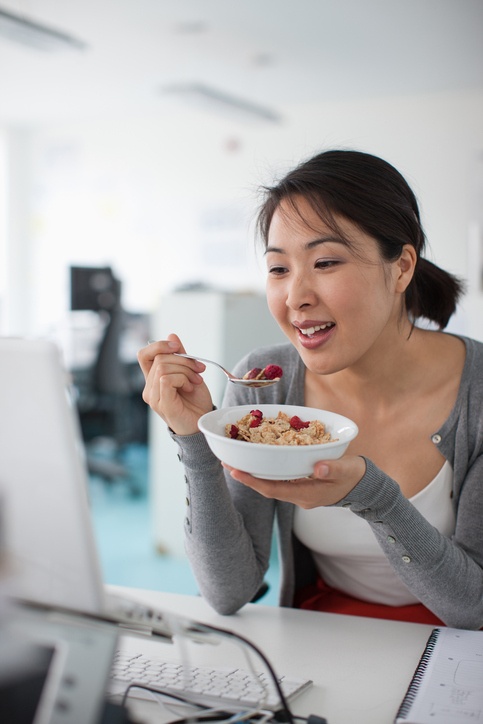 We’ve all heard the phrase that an apple a day keeps the doctor away, but who knew that eating a balanced diet would also make you more productive at work? That’s what was found in a study conducted by Brigham Young University on 19,000 employees from three large companies (published in the Population Health Management journal). It was discovered that employees with unhealthy diets were 66% less productive than those who ate whole grains, fruits, and vegetables.
We’ve all heard the phrase that an apple a day keeps the doctor away, but who knew that eating a balanced diet would also make you more productive at work? That’s what was found in a study conducted by Brigham Young University on 19,000 employees from three large companies (published in the Population Health Management journal). It was discovered that employees with unhealthy diets were 66% less productive than those who ate whole grains, fruits, and vegetables.
So how can you be a more productive employee? Try these three simple ways to eat more balanced meals and then get ready to impress your boss.
Whole-grain Goodness
Swap out your old rice, pasta, bread, and cereal for grains that are higher in fiber and are less processed. Brown and wild rice are excellent alternatives to white rice. Whole-wheat pasta, couscous, quinoa, millet, and oats are more high-fiber options to incorporate into your diet.
When it comes to breads and cereal, check the label. Choose options that have at least 3 grams of fiber per serving. Check out the Whole Grains Council website for more information.
Fabulous Fruits
Most people need three pieces of fruit per day to meet their individual requirements. This can easily be done by incorporating a fruit in your morning cereal or oatmeal, grabbing an apple or banana for a quick and portable snack, or having a bowl of sweet berries after dinner for dessert. The vitamins, minerals, antioxidants, and fiber in fruit are all great reasons to include them in your diet.
Varied Veggies
One of the most challenging food groups to get into your diet, but also one of the best for you, is vegetables. It can be difficult to meet that 4–5 recommended servings per day, so how can you get these in to help balance your diet?
One way is to make sure that you are spreading them out throughout the day by including a vegetable serving at lunch and/or snack time. At lunch, grab portable veggies such as baby carrots, cherry tomatoes, mini bell peppers, and sugar-snap peas to add some variety and crunch along with your typical sandwich. Or nibble on veggies with a hummus dip for an afternoon snack. Make it a goal to try one new/different vegetable each week.
***
Now that you know the impact of nutrition on employee health and productivity, you can follow these three tips for healthy meals and snacks.
This blog was written by Angie Mitchell, RD, Wellness Coordinator. To find out more about the NIFS bloggers, click here.


 Can you remember preschool when the teacher would turn down the lights and break out the cots? Nap time! You might not have had that exact experience, but as humans we are prone to napping. In our go-go-go life, time is money. To society, sleeping during the day is seen as a luxury that we cannot provide ourselves, and is usually thought of as a sign of laziness.
Can you remember preschool when the teacher would turn down the lights and break out the cots? Nap time! You might not have had that exact experience, but as humans we are prone to napping. In our go-go-go life, time is money. To society, sleeping during the day is seen as a luxury that we cannot provide ourselves, and is usually thought of as a sign of laziness. We have all heard the phrase that an apple a day keeps the doctor away, but who knew that eating a balanced diet would also make you more productive at work? A study conducted by Brigham Young University and published in Population Health Management Journal, found that 19,000 employees from three large companies with unhealthy diets, were 66 percent less productive than those who ate whole grains, fruits, and vegetables.
We have all heard the phrase that an apple a day keeps the doctor away, but who knew that eating a balanced diet would also make you more productive at work? A study conducted by Brigham Young University and published in Population Health Management Journal, found that 19,000 employees from three large companies with unhealthy diets, were 66 percent less productive than those who ate whole grains, fruits, and vegetables.


 We have all heard that breakfast is the most important meal of the day, but what about lunch? Lunch is just as key because it allows your body to rest and renew and get geared up for the second half of the day. If you are choosing the wrong thing at lunchtime or skipping altogether, this can lead to overeating in the afternoon and evening, poor performance at work, or an unproductive evening workout.
We have all heard that breakfast is the most important meal of the day, but what about lunch? Lunch is just as key because it allows your body to rest and renew and get geared up for the second half of the day. If you are choosing the wrong thing at lunchtime or skipping altogether, this can lead to overeating in the afternoon and evening, poor performance at work, or an unproductive evening workout.


